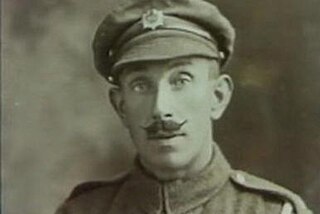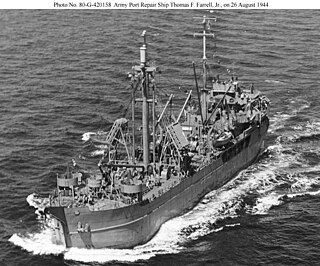
RV Calypso is a former British Royal Navy minesweeper converted into a research vessel for the oceanographic researcher Jacques Cousteau, equipped with a mobile laboratory for underwater field research. She was severely damaged in 1996 and was planned to undergo a complete refurbishment in 2009–2011 that has not been accomplished. The ship is named after the Greek mythological figure Calypso.

The Royal Indian Navy (RIN) was the naval force of British India and the Dominion of India. Along with the Presidency armies, later the Indian Army, and from 1932 the Royal Indian Air Force, it was one of the Armed Forces of British India.

Richard George Masters VC was an English recipient of the Victoria Cross, the highest and most prestigious award for gallantry in the face of the enemy that can be awarded to British and Commonwealth forces.

The Ton class were coastal minesweepers built in the 1950s for the Royal Navy, but also used by other navies such as the South African Navy and the Royal Australian Navy. They were intended to meet the threat of seabed mines laid in shallow coastal waters, rivers, ports and harbours, a task for which the existing ocean-going minesweepers of the Algerine-class were not suited.

The Belgian Navy, officially the Naval Component of the Belgian Armed Forces, is the naval service of Belgium.

HMS Greetham was one of 93 ships of the Ham class of inshore minesweepers. All ships in this class had names chosen from villages ending in -ham. The minesweeper was built by the firm of Herd & McKenzie in Buckie, Moray and was named after Greetham, Lincolnshire. Entering service in 1955, the vessel was transferred to the Libyan Navy in 1962 on loan and permanently in 1966. Renamed Zuara, the minesweeper was used as a patrol vessel until 1973. Zuara was sold to Captain Morgan Cruises of Malta for commercial use and renamed Lady Davinia. The ship was taken out of service in 2007 and laid up at Sliema Creek. Lady Davinia sank at her moorings in 2008 and for a short time became a diving attraction but in 2011 the wreck was partially broken up after being named a navigational hazard.
HMS Mersham was a Ham-class minesweeper of the Royal Navy. All ships of the class were named after villages ending in -ham. The minesweeper was named after Mersham in Kent. Constructed at Appledore, in Devon, Mersham was launched in April 1954 and completed in January 1955. In April 1955, the ship was transferred to the French Navy and in French service, was known by its pennant number, M773, until it was renamed Violette in 1964. Throughout the 1950s and early 1960s, the vessel undertook minesweeping duties from Brest in Brittany, before being laid up in 1965. In 1974, the ship was transferred to the Gendarmerie and undertook patrol duties until finally being decommissioned in 1987.

HMS Neasham (M2712/IMS49) was a Ham-class minesweeper for the Royal Navy. The names of the Ham-class vessels were all chosen from villages ending in -ham. HMS Neasham was named after Neasham in County Durham.
HMS Powderham was one of 93 ships of the Ham class of inshore minesweepers named after villages ending in -ham, in this case Powderham in Devon. She was launched on 27 November 1958 by J. Samuel White & Company Ltd, Cowes and commissioned in 1959. She was allocated pennant number M 2720.

USS Disdain (AM-222) was an Admirable-class minesweeper built for the United States Navy during World War II and in commission from 1944 to 1945. She was transferred to the Soviet Union in 1945 and after that served in the Soviet Navy as T-271.

Mira (AK-84) was never commissioned and thus never bore the USS designation. The ship was transferred to become the U.S. Army Corps of Engineers Port Repair ship Robert M. Emery the day after acquisition by Navy.

The Fundy-class minesweepers were a class of four minesweepers operated by the Royal Canadian Navy during the Second World War. All four ships entered service in 1938 and the class were discarded in 1945, sold for mercantile service. Three ended up sold to Chinese interests, while one remained active in Canada until 1987.

Naval trawlers are vessels built along the lines of a fishing trawler but fitted out for naval purposes; they were widely used during the First and Second World Wars. Some—known in the Royal Navy as "Admiralty trawlers"— were purpose-built to naval specifications, others adapted from civilian use. Fishing trawlers were particularly suited for many naval requirements because they were robust vessels designed to work heavy trawls in all types of weather, and had large clear working decks. A minesweeper could be created by replacing the trawl with a mine sweep. Adding depth charge racks on the deck, ASDIC sonar below, and a 3-inch (76 mm) or 4-inch (102 mm) gun in the bow equipped the trawler for anti-submarine duties.

The Mark 8 Landing Craft Tank were landing craft tank ships operated by the British Armed Forces. The vessels were based on an American design, but improved into ocean-going vessels capable of sailing to and operating in the Far East.
HMCS Grandmère was a Bangor-class minesweeper constructed for the Royal Canadian Navy during the Second World War. Entering service in 1941, the minesweeper took part in the Battle of the Atlantic and the Battle of the St. Lawrence before being taken out of service in 1945. The ship was sold for mercantile service following the war, first as the yacht Elda and then the cargo ship Jacks Bay. The ship was sold for scrap in 1968.
HMCS Mahone was a Bangor-class minesweeper constructed for the Royal Canadian Navy during the Second World War. Entering service in 1941, the ship took part in the Battle of the Atlantic and the Battle of the Saint Lawrence as a convoy escort. Following the war, the minesweeper was decommissioned and placed in reserve. Reacquired during the Korean War, Mahone was never recommissioned into the Royal Canadian Navy and was instead sold to the Turkish Navy in 1958. Renamed Beylerbeyi, the minesweeper remained in service until 1972 when she was discarded.

HMCS Westmount was a Bangor-class minesweeper that served with the Royal Canadian Navy during the Second World War. Entering service in 1942, the minesweeper spent the entire war on the Atlantic Canada coast. Following the war, the ship was laid up in reserve until reacquired in 1952 during the Korean War. Never re-entering service with the Royal Canadian Navy, the vessel was sold to the Turkish Navy in 1958. Renamed Bornova, the minesweeper was discarded in 1972.
HMCS Cowichan was a Bay-class minesweeper that served in the Royal Canadian Navy during the Cold War. The minesweeper entered service in 1953 and was transferred to the French Navy in 1954. Renamed La Malouine, the ship was converted to a territorial patrol vessel in 1973 and remained in service until 1977. La Malouine was sunk as a target ship in 1985.
Junella was a fishing trawler, best known for her service with the Royal Navy during the Falklands War. She was built in 1975 for J Marr & Son, a Hull-based fishing company. On 11 April 1982 she was taken up from trade by the British government and commissioned into the Royal Navy. She was fitted with Second World War era minesweeping gear at Rosyth Dockyard, manned by Royal Navy sailors and allocated to the 11th Mine Countermeasures Squadron. She sailed on 26 April but was unable to commence sweeping until after the 14 June Argentine surrender. In the meantime she was utilised to transfer troops and stores between ships and landed special forces troops at San Carlos. Demining operations commenced on 21 June. Junella returned to the United Kingdom on 11 August, carrying a defused Argentine mine.

HMSAS Protea was the first hydrographic survey ship used by the South African Naval Service. The ship was laid down as a minesweeper to be named HMS Ventnor in 1917 but was renamed HMS Verwood in 1918 while under construction. She was again re-named and launched as HMS Crozier on 1 July 1919. The vessel was converted from a minesweeper to a hydrographic survey vessel in 1921 and transferred to the South African forces in 1922, where she was commissioned as HMSAS Protea. She served as a survey vessel until 1933 when she was returned to the Royal Navy. Protea was eventually sold by the Royal Navy and renamed MV Queen of the Bay where she went on to operate as a pleasure craft out of Blackpool. She was subsequently sold to the Spanish Navy and renamed Lieutenant Captain Remigio Verdia, and used as supply vessel to run blockades, smuggling supplies to the anti-fascists in Spain during the civil war. She ran aground and sunk off Cartagena in Spain in 1939.













